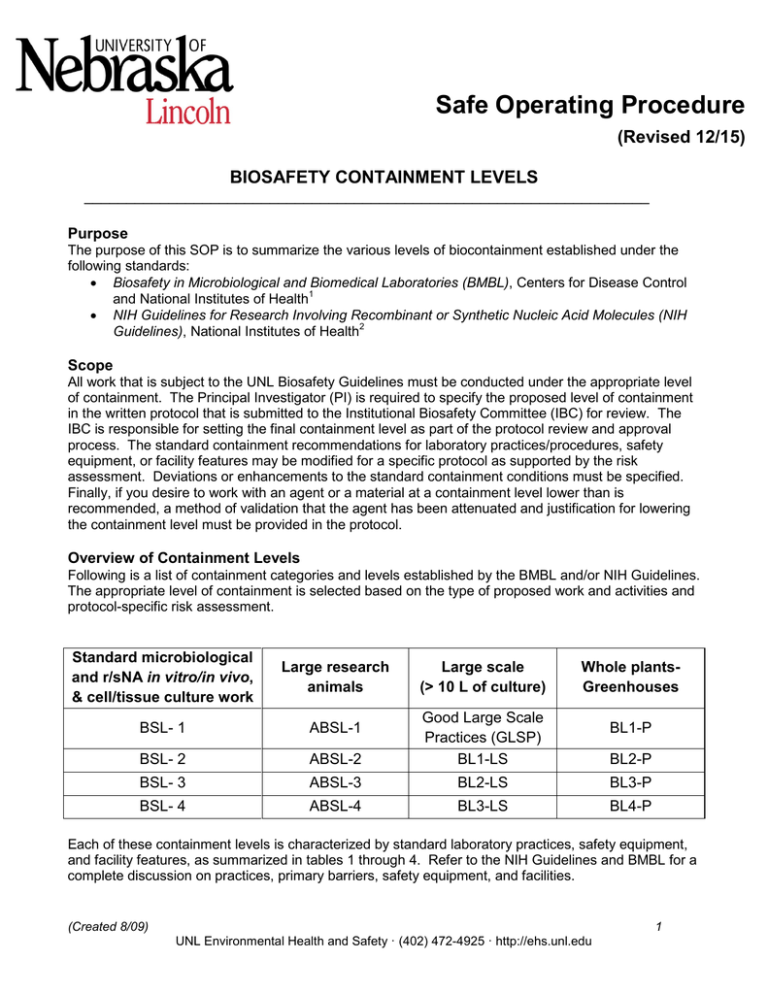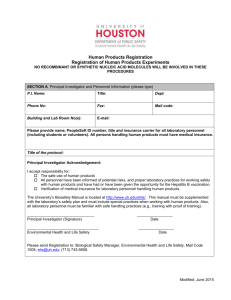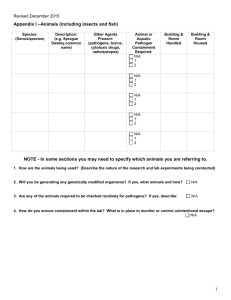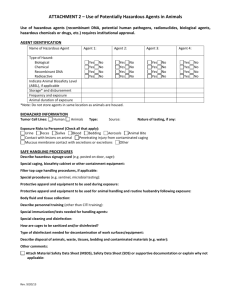Safe Operating Procedure (Revised 12/15) BIOSAFETY CONTAINMENT LEVELS
advertisement

Safe Operating Procedure (Revised 12/15) BIOSAFETY CONTAINMENT LEVELS ___________________________________________________________________ Purpose The purpose of this SOP is to summarize the various levels of biocontainment established under the following standards: • Biosafety in Microbiological and Biomedical Laboratories (BMBL), Centers for Disease Control and National Institutes of Health1 • NIH Guidelines for Research Involving Recombinant or Synthetic Nucleic Acid Molecules (NIH Guidelines), National Institutes of Health2 Scope All work that is subject to the UNL Biosafety Guidelines must be conducted under the appropriate level of containment. The Principal Investigator (PI) is required to specify the proposed level of containment in the written protocol that is submitted to the Institutional Biosafety Committee (IBC) for review. The IBC is responsible for setting the final containment level as part of the protocol review and approval process. The standard containment recommendations for laboratory practices/procedures, safety equipment, or facility features may be modified for a specific protocol as supported by the risk assessment. Deviations or enhancements to the standard containment conditions must be specified. Finally, if you desire to work with an agent or a material at a containment level lower than is recommended, a method of validation that the agent has been attenuated and justification for lowering the containment level must be provided in the protocol. Overview of Containment Levels Following is a list of containment categories and levels established by the BMBL and/or NIH Guidelines. The appropriate level of containment is selected based on the type of proposed work and activities and protocol-specific risk assessment. Standard microbiological and r/sNA in vitro/in vivo, & cell/tissue culture work Large research animals BSL- 1 ABSL-1 BSL- 2 ABSL-2 Good Large Scale Practices (GLSP) BL1-LS BSL- 3 ABSL-3 BL2-LS BL3-P BSL- 4 ABSL-4 BL3-LS BL4-P Large scale (> 10 L of culture) Whole plantsGreenhouses BL1-P BL2-P Each of these containment levels is characterized by standard laboratory practices, safety equipment, and facility features, as summarized in tables 1 through 4. Refer to the NIH Guidelines and BMBL for a complete discussion on practices, primary barriers, safety equipment, and facilities. (Created 8/09) 1 UNL Environmental Health and Safety · (402) 472-4925 · http://ehs.unl.edu Standard Laboratory Biosafety Levels The levels are designated in ascending order, by degree of protection provided to personnel, the environment, and the community. Standard microbiological practices are common to all laboratories. Special microbiological practices enhance worker safety, environmental protection, and address the risk of handling agents requiring increasing levels of containment. TABLE 1 Standard microbiological and r/sNA in vitro/in vivo and cell/tissue culture work BSL PRACTICES Standard Microbiological Practices 1 PRIMARY BARRIERS AND SAFETY EQUIPMENT None required FACILITIES (SECONDARY BARRIERS) Laboratory bench and sink required BSL-1 practice plus: • Limited access • Biohazard warning signs • “Sharps” precautions • Biosafety manual defining any needed waste decontamination or medical surveillance policies Primary barriers: BSL-1 facilities plus: • Class I or II BSCs or other • Autoclave available physical containment devices used for all manipulations of agents that cause splashes or aerosols of infectious materials Personal Protective Equipment: • Laboratory coats; gloves; face protection as needed BSL-2 practice plus: Primary barriers: BSL-2 facilities plus: • Controlled access • Class I or II BSCs or other • Physical separation from physical containment access corridors • Decontamination of all devices used for all open waste • Self-closing, double-door manipulation of agents access • Decontamination of laboratory clothing before Personal Protective • Exhaust air not recirculated Equipment: laundering • Negative airflow into • Protective laboratory • Baseline serum laboratory clothing; gloves; respiratory protection as needed Not allowed at UNL. Refer to the BMBL for a summary of required practices, primary barriers and safety equipment, and facilities (secondary barriers). 2 3 4 th From BMBL 5 Ed. 1 (Created 8/09) 2 UNL Environmental Health and Safety · (402) 472-4925 · http://ehs.unl.edu Animal Biosafety Levels The four ABSLs in Table 2 describe animal facilities and practices applicable to work with animals infected with agents assigned to Biosafety Levels 1-4, respectively. Investigators that are inexperienced in conducting these types of experiments should seek help in designing their experiments from the IACUC, IBC and other scientists who are experienced in this special work. TABLE 2 Summary of Recommended Biosafety Levels for Activities in Which Experimentally or Naturally Infected Vertebrate Animals Are Used FACILITIES PRIMARY BARRIERS AND ABSL PRACTICES (SECONDARY SAFETY EQUIPMENT BARRIERS) 1 2 3 Standard animal care and management practices, including appropriate medical surveillance programs As required for normal care of each species ABSL-1 practices plus: • Limited access • Biohazard warning signs • “Sharps” precautions • Biosafety manual • Decontamination of all infectious wastes and of animal cages prior to washing ABSL-2 practices plus: • Controlled access • Decontamination of clothing before laundering • Cages decontaminated before bedding removed • Disinfectant foot bath as needed ABSL-1 equipment plus primary barriers: • Containment equipment appropriate for animal species Personal Protective Equipment: • Laboratory coats, gloves, face and respiratory protection as needed ABSL-2 equipment plus: • Containment equipment for housing animals and cage dumping activities • Class I, II or III BSCs available for manipulative procedures (inoculation, necropsy) that may create infectious aerosols. PPEs: • Appropriate respiratory protection Standard animal facility: • No recirculation of exhaust air • Directional air flow recommended • Hand washing sink ABSL-1 plus: • Autoclave available • Mechanical cage washer recommended ABSL-2 facility plus: • Physical separation from access corridors • Self-closing, double-door access • Sealed penetrations • Sealed windows • Autoclave available in facility Not allowed at UNL. Refer to the BMBL and additional references for a summary of required practices, primary barriers and safety equipment, and facilities (secondary barriers) 4 th From BMBL 5 Ed. 1 Additional References: Institute for Laboratory Animal Research. Guide for the Care and Use of Laboratory Animals. Washington, DC: National Academy Press; current edition. National Institutes of Health, Office of Laboratory Animal Welfare. Public Health Service Policy on Humane Care and Use of Laboratory Animals, Bethesda (MD); The National Institutes of Health (US); 2000. Federation of Animal Science Societies. Guide for the Care and Use of Agricultural Animals in Research and Teaching; current edition. (Created 8/09) 3 UNL Environmental Health and Safety · (402) 472-4925 · http://ehs.unl.edu In addition to the animal biosafety levels described in this section, the USDA has developed facility parameters and work practices for handling agents of agriculture significance. Appendix D of the BMBL includes a discussion on Animal Biosafety Level 3 Agriculture (BSL-3-Ag). USDA requirements are unique to agriculture because of the necessity to protect the environment from pathogens of economic or environmental impact. Large Scale Biosafety Levels Appendix K of the NIH Guidelines specifies physical containment guidelines for large-scale (greater than 10 liters of culture) research or production involving viable organisms containing recombinant or synthetic nucleic acid molecules. It shall apply to large-scale research or production activities as specified in Section III-D-6 of the NIH Guidelines, titled: “Experiments Involving More than 10 Liters of Culture.” It is important to note that this appendix addresses only the biological hazard associated with organisms containing recombinant or synthetic nucleic acid molecules. Other hazards accompanying large-scale cultivation of such organisms (e.g., toxic properties of products; physical, mechanical, and chemical aspects of downstream processing) are not addressed and shall be considered separately, albeit in conjunction with this appendix. The provisions of Appendix K listed in Table 3 below supersede those of Table 1 when quantities in excess of 10 liters of culture are involved in research or production. TABLE 3 Large scale research or production of organisms, including those containing r/sNA (> 10 L of culture) PRIMARY BARRIERS FACILITIES BL-LS PRACTICES AND (SECONDARY BARRIERS) SAFETY EQUIPMENT GLSP • Standard Microbiological Practices • Written instructions and training of personnel shall be provided to assure that cultures of viable organisms containing r/sNA molecules are handled prudently and that the work place is kept clean and orderly. • Addition of materials to a system, sample collection, transfer of culture fluids within/between systems and processing of culture fluids are done in a manner that minimizes the health risk to workers • An emergency response plan shall be developed and include provisions for handling spills. Barriers: • Systems designed to contain culture fluid and viable organisms PPE • Provided as appropriate • Hand washing sink, shower, changing area available as appropriate (Created 8/09) 4 UNL Environmental Health and Safety · (402) 472-4925 · http://ehs.unl.edu TABLE 3 Large scale research or production of organisms, including those containing r/sNA (> 10 L of culture) PRIMARY BARRIERS FACILITIES BL-LS PRACTICES AND (SECONDARY BARRIERS) SAFETY EQUIPMENT 1 2 GLSP facilities plus: • Spills and accidents reported immediately to the Lab Director; medical evaluation, surveillance and treatment provided as appropriate and recorded • Minimization of aerosol formation when adding materials to the closed system or transferring between closed systems • Emergency plans contain procedures for handling large losses of culture GLSP barriers and PPE plus: • Cultures of viable organisms handled in a closed system or other primary containment equip. (e.g., BSC with centrifuge for processing culture fluids) • Culture fluids are not removed from containment unless the organisms have been inactivated • Sample collection from a closed system, the addition of materials to a closed system, and the transfer of culture fluids for one closed system to another shall be conducted in a manner that minimizes the release of aerosols or contamination of exposed surfaces. GLSP facilities plus: • HEPA filters in place to treat exhaust gases from closed systems or other primary containment equip. and prevent release of viable biological materials • Closed systems shall not be opened for maintenance or other purposes unless the system has been sterilized and validated (unless intended as the final product) BL1-LS plus: • Spills and accidents reported immediately to the BSO, IBC, NIH/OBA, and other authorities, as appropriate; medical evaluation, surveillance and treatment provided as appropriate and recorded • Closed systems are permanently identified and the identification used in all records • Biohazard signs are posted on each closed system and primary containment equipment BL1-LS equipment plus: • Closed systems for propagation and growth shall have monitoring systems to verify containment integrity during operation • Closed systems are tested for integrity of containment with the host organism to be used; records are kept BL1-LS Facilities plus: • Rotating seals and other mechanical devices associated with closed systems are designed to prevent leakage or enclosed in ventilated housings with HEPA filters • A closed system shall be permanently identified and the identification used in all records reflecting testing, operation, and maintenance BL2-LS Practices plus: • Specific entry and exit procedures and restrictions. BL2-LS primary barriers, equipment, and PPE plus: • Head space above culture in closed system is maintained at a pressure as low as possible to maintain containment integrity • Garment change out required. BL2-LS Facilities Plus: • Controlled area (double-doored space, separation from remaining facility, sealed penetrations, etc.) • Hands free sink operation • Shower • Negative air flow with HEPA filtration on exhaust 3 From Appendix K of the NIH Guidelines 2 (Created 8/09) 5 UNL Environmental Health and Safety · (402) 472-4925 · http://ehs.unl.edu Biological Containment for Plants, Plant Pathogens, and Vectors The containment principals, practices, and facilities described in tables 4a and 4b presume that the biological material(s)/agent(s) pose no health threat to humans and animals and are therefore intended primarily to minimize the possibility of an unanticipated deleterious effect on organisms and ecosystems outside of the experimental facility (e.g., the inadvertent spread of a serious pathogen from a greenhouse to a local agricultural crop or the unintentional introduction and establishment of an organism in a new ecosystem). Table 4a – Principals of Containment for Plants, Plant Pathogens, and Vectors Plants • • • • • • Use genetic engineering techniques that localize transgenes to nonpropagative plant parts or confer plant sterility Cover or remove flower and seed heads to prevent pollen and seed dispersal Use male sterile strains Harvest the plant material prior to the reproductive stage Control flowering time so pollen shed does not occur during the receptive period of nearby crossfertile plants Ensure that cross-fertile plants are not growing within the known pollen dispersal range of the experimental plant Microbes • • • • • • • Genetically disable the microbes to minimize survival and reproduction Avoid creating aerosols when inoculating plants Provide adequate distance between an infected plant and another susceptible host; especially if dissemination can occur through the air or by leaf contact Grow experimental plants and microbes at a time of year when susceptible plants are not growing nearby Eliminate vectors for insect-borne microbes Choose microbes with an obligate association with the host plant Treat runoff water to kill living organisms Insects • • • • • • Choose or create non-flying, flightimpaired, or sterile strains Conduct experiments at a time of year when escaped organisms will not survive Choose organisms that do not have an obligate association with nearby plants Treat or evaporate runoff water to eliminate viable larvae and eggs Avoid use of small insects in greenhouse cages Destroy all pollinating insects in cages after pollen transfer Only the plant containment levels that exist at UNL are listed in Table 4b. Higher plant containment levels exist and the requirements of these plant biosafety levels (BL3-P and BL4-P) are detailed in Appendix P of the NIH Guidelines1 as well as in the document “A Practical Guide to Containment: Greenhouse Research with Transgenic Plants and Microbes.” (Created 8/09) 6 UNL Environmental Health and Safety · (402) 472-4925 · http://ehs.unl.edu Table 4b – Containment Practices and Facilities for Plants, Arthropods and their Associated Microbes in Greenhouses BL-P 1 2 PRACTICES Standard BSL-1 Practices plus: • Personnel must read and follow written greenhouse practices and procedures • Experiments currently in progress are recorded • Inactivation of experimental organisms before disposal outside of greenhouse • Undesired species control plan implemented • Motile macroorganisms are housed in appropriate cages and if released, escape from the facility is minimized BL1-P practices plus: • Access to the greenhouse shall be limited or restricted, at the discretion of the Greenhouse Director, to individuals directly involved with the experiments when they are in progress. • Records are maintained of all plants, microbes or small animals brought in or removed from the facility. Materials containing experimental microorganisms, which are brought into or removed from the greenhouse facility in a viable or intact state, shall be transferred in a closed non-breakable container. • Any accidental spill or release of microbe shall be reported to the GD*, IBC, NIH/OBA and/or other applicable authorities • Decontamination of run-off water is recommended • Gravel or similar floors should be treated periodically to inactivate/eliminate potentially trapped organisms • Signs must be posted when a restricted experiment is in progress • Signs should be posted if organisms with potential for detrimental impact on managed or natural ecosystems and/or risk to human health are present • A greenhouse practices manual should be prepared and include contingencies for unintentional release of organisms FACILITIES (SECONDARY BARRIERS) • Greenhouse floor is composed of gravel or other porous material and walkways are of an impervious material (e.g., concrete) • Windows and other openings may be open and do not require barriers to contain or exclude pollen, microbes, or small flying animals • Screens are recommended BL1-P facility plus: • Greenhouse floor is composed of an impervious material (e.g., concrete) • Screens on windows and openings to exclude birds and arthropods • Autoclave available • Minimize the ingress of arthropods through intake fans • Containment can be satisfied by using a growth chamber or growth room within a building that limits access and escape of micro and macroorganisms in a way that satisfies the intent of BL2-P guidelines *GD – Greenhouse Director †BSO – Biosafety Officer Additional References: A Practical Guide to Containment: Plant Biosafety in Research Greenhouses, D. Adair & R. Irwin, Information Systems for Biotechnology; Blacksburg, VA; 2008. http://www.isb.vt.edu/ United States Department of Agriculture, Animal and Plant Health Inspection Services; various guides to containment (such as Plant Pathogenic Nematodes; Plant Pathogenic Bacteria; Viral Plant Pathogens and Their Vectors; Fungal Plant Pathogens; etc.) (Created 8/09) 7 UNL Environmental Health and Safety · (402) 472-4925 · http://ehs.unl.edu







